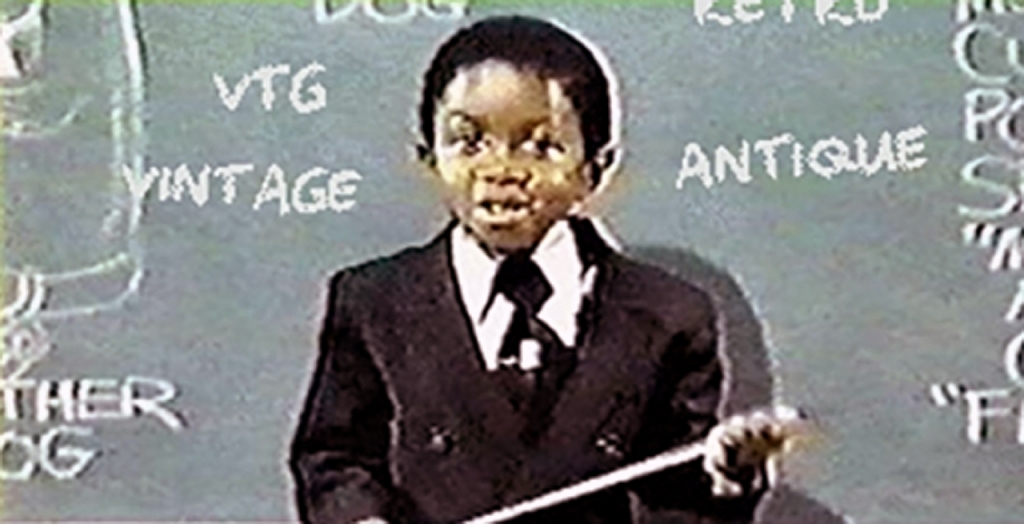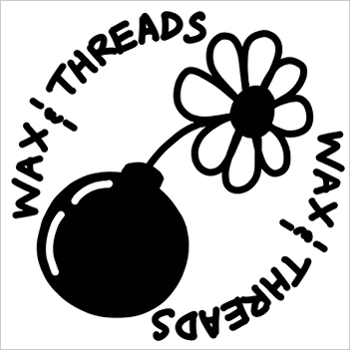Webster’s dictionary has this to say about the definition of vintage when used as an adjective:

Agreed.
But thanks to “the internets” the definition of vintage, when applied to t-shirts, has become quite muddled. This is mostly due to t-shirt manufacturers looking to leverage a popular marketing keyword. If you Google “vintage t-shirts” you won’t find a single result on page one that offers actual vintage t-shirts. Instead, you’re presented with modern-day t-shirt manufacturers who produce new items that have a vintage look (like faux wear on the design), straight-up reproductions of old designs, or new versions of retro imagery.
Webster is probably rolling around in his grave right now. Not only was he an extremely small and talented sit-com actor, but he was also a stickler for diction. Put away the tissues, I was just kidding – the little fella is still alive and he could care less about grammar.
Noah Webster on the other hand, who published dictionaries and has long since passed, is indeed rolling around in his grave.
So let’s define vintage t-shirts and other related terminology – how they are used on our site (and in reality.)
What Makes a T-Shirt “Vintage”?
Applying Webster’s definition – a “vintage t-shirt” is a t-shirt that is not new. That leaves a big grey area, but suffice to say they don’t mean one year old. Some have claimed 10, we say at least 15 years old. When the Defunkd Collective was in operation, t-shirts had to be at least 15 years old to be posted for sale. But the safest bet to define a vintage t-shirt is one that is 20 or more years old.
Currently, any t-shirt manufactured in or prior to 2004 is considered vintage.
A true vintage t-shirt can usually be identified by its tag, with most of them now defunct. 1980s tees were typically made with a 50/50 blend of polyester and cotton which ensured they were softer. In the mid to late 90s (and beyond), cotton blends became the norm.
VTG
Is a short form for Vintage. It was originally adapted as a search synonym on eBay to give sellers more room in the limited character listing titles. When comparing the two searches on eBay, they bring exactly the same search results. While Google seems to recognize it as a short form, the two variations bring back quite different results.
Vintage Bootleg
This term refers to a t-shirt that is also at least 15 years old – yet wasn’t licensed. Many of these were sold out of concert parking lots in the 1970s and 80s. They typically featured original artwork with a style that become synonymous with bootlegs. Given they are actually vintage, they are more scarce (far less were manufactured) and had original designs, they can be just as valuable as a rock artist’s licensed vintage t-shirts. Sorry, Metallica.
Bootleg Vintage or Counterfeit Vintage
These happen when dishonest people set out to create a t-shirt in modern times and pass them off for true vintage. They make their best effort to copy an original and sought-after design. They’ll find quantities of old blank tees or unbranded modern-day vintage-esque tees. Or they’ll use modern blanks with fake vintage tags sewn in. Then they’ll typically post them online alongside a small number of actual vintage t-shirts to dupe consumers into shelling out of them. Booooo.
Bootleg T-Shirt
These are modern-day bootlegs that are not licensed, yet original designs. They aren’t attempting to duplicate the design of a vintage t-shirt, yet the designs are vintage-inspired ie Rap Tee style. Modern wearers of vintage tees have accepted these into the t-shirt universe.
Retro T-Shirt
Retro tees are t-shirts manufactured in modern times, using original, yet vintage-themed artwork for a nostalgic appeal. They’re printed on new t-shirts that many times are manufactured with softer fabric blends.
Reproduction or Reissue T-Shirt
These tees are also manufactured in modern times but they use artwork that was created in another era. Some of them are licensed, some of them aren’t. Metallica for example has reissued many of their 1980s designs. To make things a touch more confusing – some of these were reissued over 15 years ago so reproductions eventually become vintage reproductions.
Raghouse / Clothing Mill / Warehouse
A raghouse or used clothing warehouse is a business that deals in textiles, often globally. They acquire large quantities of second-hand clothing, sort and grade it and export it to customers around the world. Amid this process, they will often allow pickers to enter their warehouse and charge them for finds by the pound.
CONDITION OR GRADING TERMS
Deadstock Vintage or NOS (New Old Stock)
Used to describe tees printed in another era that became excess/unsold inventory and typically ended up in storage. Most times they are in mint condition, however, sometimes storage conditions and being left unwashed can adversely affect their condition.
Distressed / Trashed
Used to describe the condition of heavily worn t-shirts. Often times tees in this condition are riddled with holes, seam separations, stains, and a faded print.
Paper-Thin / See-Through
This usually describes a vintage 50/50 t-shirt that has been so heavily washed and worn that the cotton portion of the fibers have diminished.
Dry Rot / Acid Rot / Sulfer Rot
Initially coined “dry rot“, this is a condition that affects deadstock black 100% cotton t-shirts. The ink becomes corrosive to the fibers and they weaken due to high pH levels/acidity. In some cases, they can be torn like paper.
Bacon or Spaghetti Neckline
When the neck (crew-neck) portion of a t-shirt starts losing its form and elasticity and becomes loose and stretched.
Reverse or Shadow Stain
This typically occurs on a t-shirt where someone attempted a spot stain removal, and the area with the stain is now lighter than the remainder of the fabric.
Pilling
When tiny bunches/balls of fabric begin to appear on a t-shirt.
p2p
Short for pit-to-pit measurement.
Meashys / Dimes
Short for Measurements and Dimensions.
AUCTION / BUYING TERMS
Snipe
A winning bid in the closing seconds of an auction or quick purchase that’s made before anyone else has a chance.
Killshot
A bid that is much larger than previous bid increments and is expected and intended to close out a sale.
Joy Bidder / Flaker
This term describes a customer who doesn’t pay for their purchase. Joy bidders on eBay typically drive the price of an auction up and then never pay for an item.
The Bins
This typically refers to the bins at a Goodwill, where customers are able to buy unsorted clothing that’s presented/dumped out of bins.
The Racks
This is in reference to the retail level racks at Goodwill, or other various thrift stores.
SLANG TERMS
Mid or Midrange
This refers to the value of a particular shirt, commonly selling in the $50 range.
Grail / Hammer
The definition of this appears to vary a ton but it typically refers to more expensive and/or harder to find vintage t-shirts.
Mullet
A mullet t-shirt is one that features a small print on the front, typically over the left breast, and a large print on the rear aka a “back-hit.” They were named this as an homage to the mullet hairstyle.
Back-Hit / Front Hit / Arm Hit
Refers to the locations of printing on a given t-shirt.
Vintage T-Shirt Head
Similar to a “sneakerhead” a “vintage t-shirt head” is a heavy user, wearer, or collector that has a significant portion of authentic vintage t-shirts in their wardrobe.
Old Head
This term refers to dealers who have been in the business for a long time, veteran vintage t-shirt sellers are old-heads.
Picker
A picker most often refers to an individual at a used clothing mill who sorts through the clothing and picks out items for their inventory, or for another company. But picking basically refers to the selection of inventory purchased at wholesale prices.
Fugazi
This term is used in reference to fake or counterfeit t-shirts.
Rag Brag
The act of staging vintage finds in rag houses, or thrift store racks on social media as to appear as though the picker actually discovered them there.
Double-Up
When you have more than one of the exact same t-shirt. Sometimes, because one stays in storage and the other is for wearing.
OTB, Off-the-Back Challenge
The off the back challenge is a modern-day social-based challenge where a person in public is spotted wearing a vintage t-shirt and is offered money in exchange for the t-shirt. Generally, the wearer of the shirt isn’t aware of its true value, and may or may not be compensated fairly. The elderly and homeless have been targeted by these challenges, bringing the ethics of the practice into question.
NFS or Not For Sale
Often times collectors will share a photo of a t-shirt in their personal collection, but to ward off purchase inquiries they’ll label it NFS because it’s a personal grail.
VINTAGE T-SHIRT PRINT TYPES
Screen Print
Screen-printed t-shirts go through a process using film to generate screens that each represent a single color. Ink is then spread across the screen and then cured under heat lamps. The process repeats for each color.
Heat Transfer Print / Iron-on
These prints were often created in novelty shops in the 70s and 80s and were on-demand. The customer would select a print that was then pressed on a blank t-shirt using a heat press. The prints don’t withstand the test of time, often fading and decaying over years.
Direct-to-Garment (DTG)
These machines can print on demand, one at a time. A t-shirt is placed in the machine, and the print is directed by an image you provide. They’re basically t-shirt printers and the output quality of Direct-to-Garment is now very good.
Computer Print
A one off t-shirt that was typically printed at mall kiosks in the 1980s and 1990s – usually a photograph, printed in a pixel-style, low definition, digital format.
VINTAGE T-SHIRT PRINT STYLES
All-Over Print / AOP / Megaprint
This type of screen print covers the entire shirt, front, and back. A megaprint typically means every inch of the t-shirt is printed on, including the collar and arms.
Wrap Around
A wrap-around refers to a print that starts on the front and wraps around the torso to the back.
Big Face
A tee that features a large print of a person, typically a celebrity’s face.
Big Head
Sports-based tees that feature players in caricature format with big heads.
Chest / Pocket Print
This refers to a small front print on one side of the chest.
Multi/Test Print
Multi prints were inspired by test prints done by screen printers where they used the same tee to test their ink/screens.
VINTAGE T-SHIRT CONSTRUCTION TERMS
Crew Neck
A crew-neck refers to the finishing on the neck construction of a t-shirt. It’s basically that ribbed ring of fabric around your neck that also usually contains the shirt’s tag.
Circular / Tubular Knit
Circular knit t-shirts are made from fabric knit into a tube shape.
Single Stitch / Single Dingle
Single stitch refers to the finishing stitch commonly used in the construction of a vintage t-shirt. Modern t-shirts often use a double row of stitching on the arm hem, lower hem, and well as shoulder seams.
Dual Stitch
This refers to a t-shirt that features both double and single stitch seams, for example, single stitch on the arm openings while the bottom hem features double stitch.
Double Trouble / Double Double (CDN)
A t-shirt that features more modern double-stitching.
FABRIC TERMS
100% Cotton
The entire shirt is made up for cotton fibers.
50/50
Is a t-shirt that contains 50% cotton and 50% polyester fibers.
Tri-Blend
Is a t-shirt that contains 3 different fibers, often in a blend of 50% polyester, 35% cotton, and 15% rayon.
Rayon-Blend
Is a t-shirt that has been blended with cotton. Some Champion t-shirts have an 88% cotton 12% rayon blend.
100% Synthetic
Sometimes shirts are made with 100% polyester or nylon, with no natural fibers.
Heathered
When different colored fibers are combined to produce a speckled, subtle color. The most common example of this is “heathered grey” often present in rayon blended t-shirts.
TAG TERMS
Sewn-in Tag
Tag Swap
This is when a tag is added aftermarket to a t-shirt, by either a manufacturer or counterfeiter. When a manufacturer does it, the tag is usually sewn in where the tag would usually go, but above the neck seam flap rather than neatly tucked away under it. When a counterfeiter does it, they attempt to install a tag neatly under the neckline to mislead a buyer.
Printed Tag or Label
Rather than having a piece of fabric attached to the inside neckline – a printed tag is one that is screen printed on the inside of the garment. This came to be a trend in the mid-2000s, but had been done by independent screen print artists as early as the 1970s.
VINTAGE T-SHIRT TYPES
Ringer
Ringer tees have colored “rings” as the neck and arm cuff openings. The arms are typically fitted as well, with smaller openings. A white-based t-shirt for example might have a red collar and arm seams.
Silent Ringer
A silent ringer is a ringer shirt with rings that are the same color as the rest of the t-shirt.
Jersey / Raglan
This type of t-shirt commonly has different color arms that are 3/4 in length and might also have a non-linear lower hem. They were inspired by warm-up jersey shirts worn by baseball players.
Pocket-Tee
This refers to t-shirts that have a small pocket, typically over the left breast.
Long Sleeve
Long sleeve t-shirts feature full-length arms.
Sleeveless
Sleeveless t-shirts are those without sleeves. They are sometimes in an undershirt format, other times just missing the arm piece for a clean line at the shoulder.
Our guides:
Vintage T-Shirts 103: The Brand Gallery
Jimmy founded Defunkd in 2004 when he started selling vintage t-shirts online. 20 years of experience later and he hasn't looked back since. Actually, he looks back all the time given he's a sucker for nostalgia. For more, check the history of Defunkd and Jimmy's Expertise.
- Jimmy Jhttps://www.defunkd.com/author/admin/
- Jimmy Jhttps://www.defunkd.com/author/admin/
- Jimmy Jhttps://www.defunkd.com/author/admin/
- Jimmy Jhttps://www.defunkd.com/author/admin/





